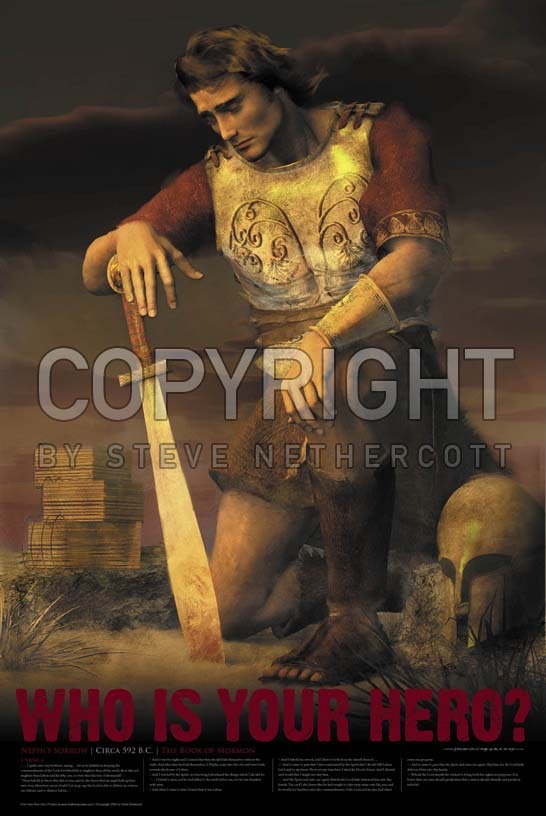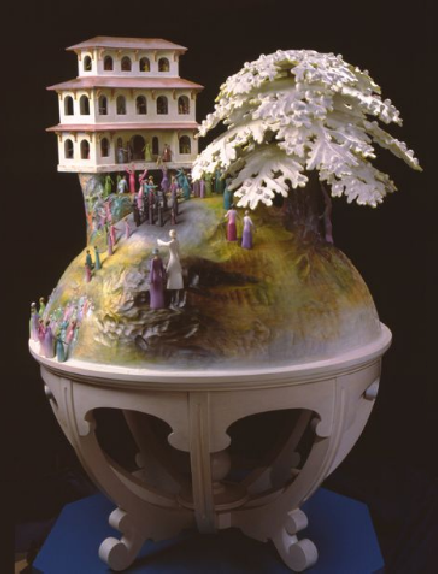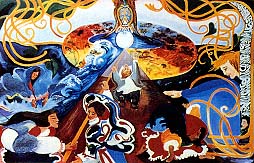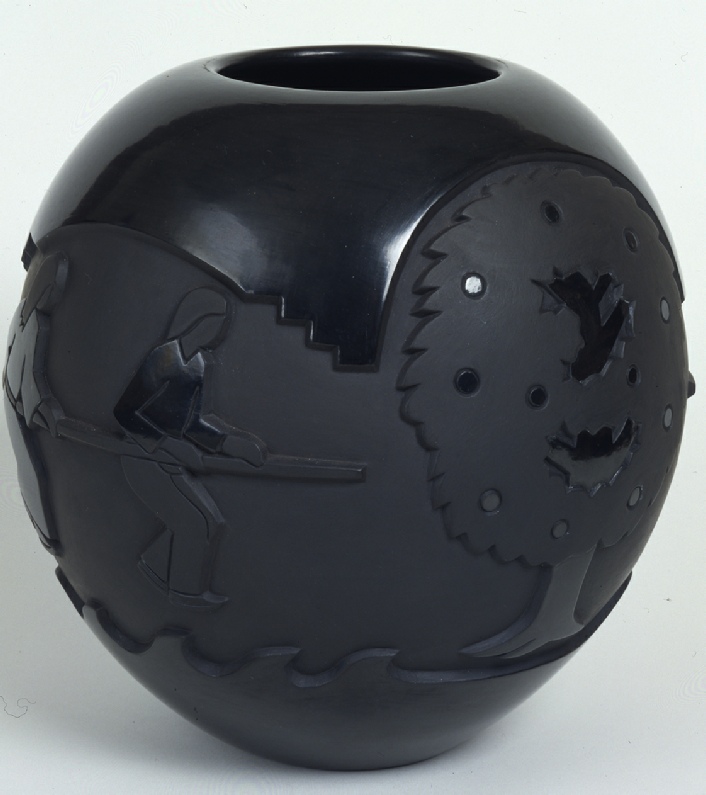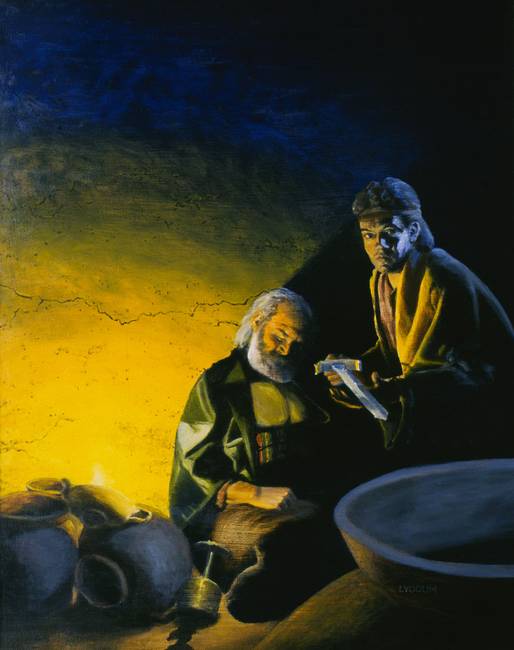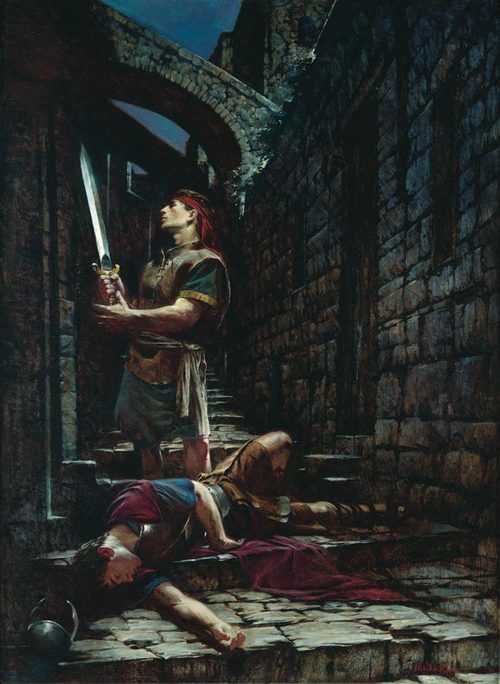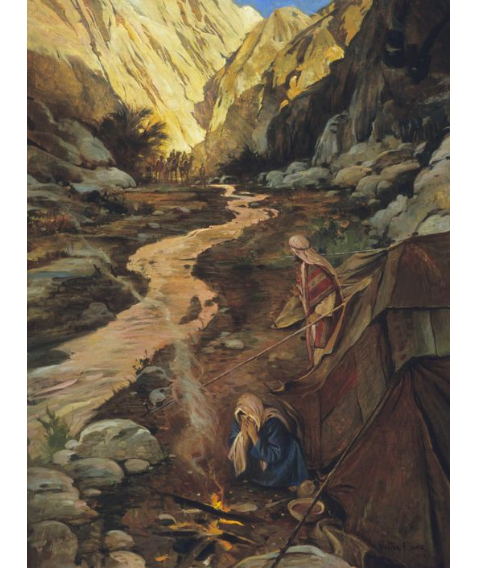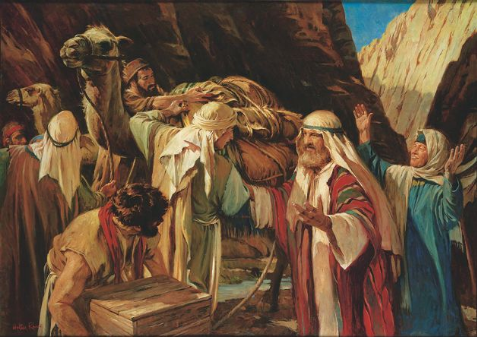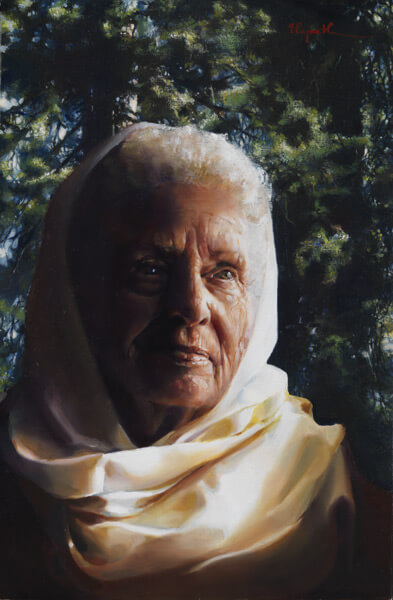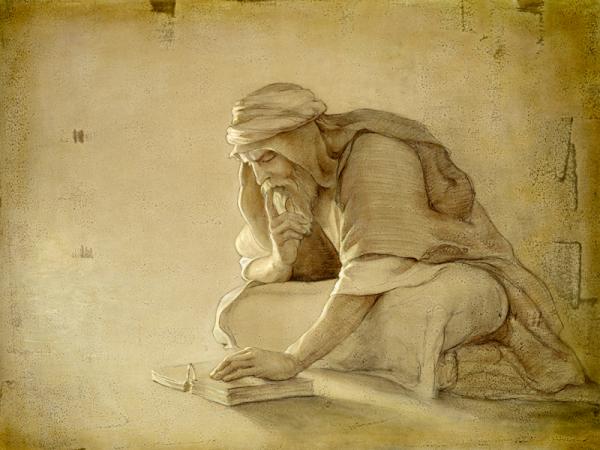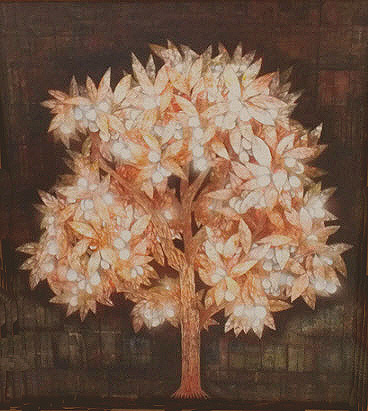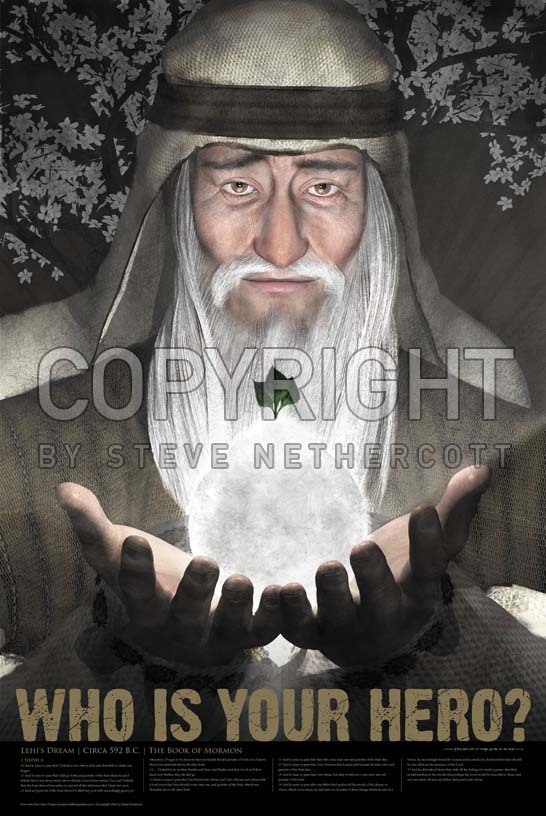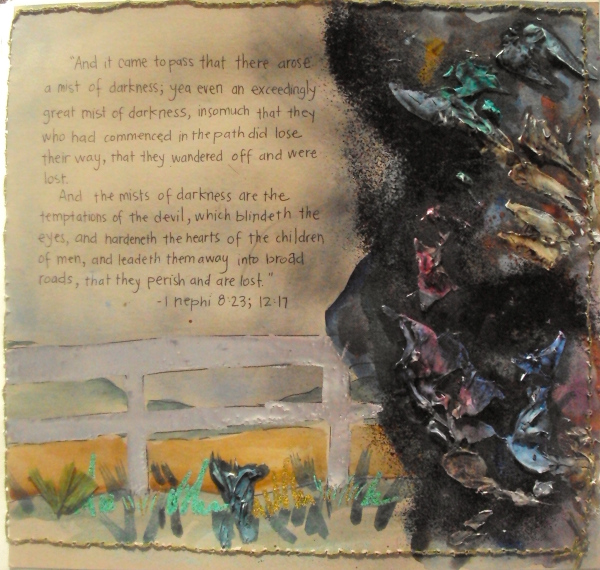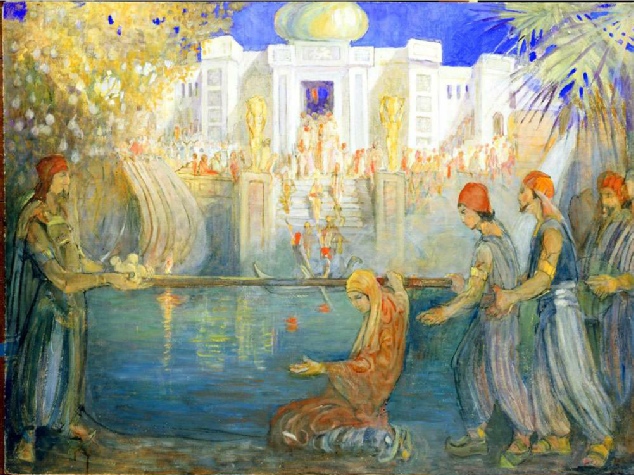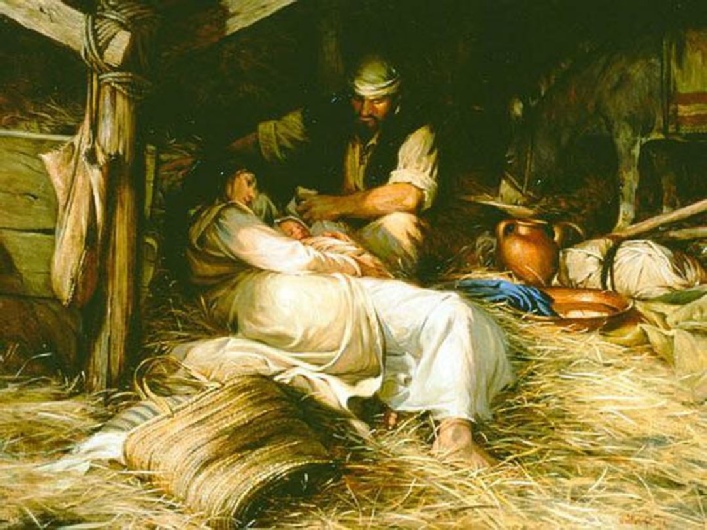






Book of Mormon Feast
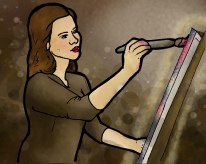
An Artistic Tour of 1 Nephi 1-11
1 Nephi 1:1
BOOK OF MORMON MUSIC
“We’ll Bring the World His Truth” – by Janice Kapp Perry
Nephi says that he was born of goodly parents and he knows the goodness of God,
therefore he wrote a record which brings truth to the world. Acapella group Inside
Out illustrates the song with pictures of Latter-
Children’s Songbook, 172
1 Nephi 2:15
BOOK OF MORMON POETRY
“And My Father Dwelt in a Tent,” -
1 Nephi 3:1-
BOOK OF MORMON MUSIC
“Nephi’s Courage” – Bill N. Hansen Jr. & Lisa T. Hansen
The Lord gave Nephi’s family a difficult assignment: return to Jerusalem and acquire the plates of brass, the history of his people, which was kept by a wealthy relative. Nephi’s brother complained, but Nephi expressed his faith: “I will go and do the things which the Lord hath commanded, for I know that the Lord giveth no commandment unto the children of men, save he shall prepare a way for them that they may accomplish the thing which he commandeth them.”
This Linda Mat Kids presentation is illustrated.
Children’s Songbook, 120
1 Nephi 3:24
BOOK OF MORMON ART
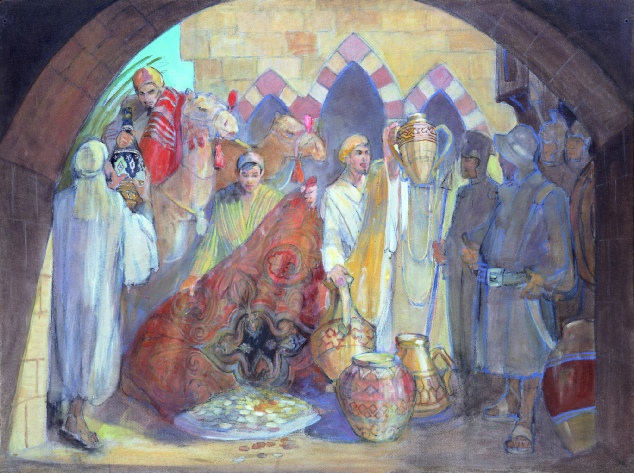
Treasures in Exchange for the Plates of Brass
Minerva Teichert
Lehi’s sons’s second attempt to get the Plates of Brass, as commanded by the Lord: “And it came to pass that we went in unto Laban, and desired him that he would give unto us the records which were engraven upon the plates of brass, for which we would give unto him our gold, and our silver, and all our precious things.”
1 Nephi 4:6
BOOK OF MORMON ART
Elspeth Young
“And I was led by the Spirit, not knowing beforehand the things which I should do.” Thus Nephi describes his final successful acquisition of the plates of brass, as directed by the Lord.
In the Book of Mormon, young Nephi and his brothers have the commission to obtain the sacred record, so that their descendants will know the commandments of the Lord. They’ve unsuccessfully tried several ways to obtain them, and Nephi knows that he can only rely upon the Lord for help, because he is on the Lord’s errand.
1 Nephi 4:7-
BOOK OF MORMON ART
Lester Yocum
“Nevertheless I went forth, and as I came near unto the house of Laban I beheld a man, and he had fallen to the earth before me, for he was drunken with wine. And when I came to him I found that it was Laban. And I beheld his sword, and I drew it forth from the sheath thereof.”
Artist’s notes:
“Nephi ponders what to do with the man who has done so much harm to his family, now found drunk and helpless in an alley at night.”
1 Nephi 4:10-
BOOK OF MORMON ART
Real Heroes Posters – Steve Nethercott
Nephi faced a dilemma – to stay in his comfort zone, or to do a difficult thing that the Lord was commanding him. The Book of Mormon says,
“And it came to pass that I was constrained by the Spirit that I should kill Laban; but I said in my heart: Never at any time have I shed the blood of man. And I shrunk and would that I might not slay him.
“And the Spirit said unto me again: Behold the Lord hath delivered him into thy hands.
“Yea, and I also knew that he had sought to take away mine own life; yea, and he would not hearken unto the commandments of the Lord; and he also had taken away our property.
“And it came to pass that the Spirit said unto me again: Slay him, for the Lord hath delivered him into thy hands. Behold the Lord slayeth the wicked to bring forth his righteous purposes. It is better that one man should perish than that a nation should dwindle and perish in unbelief.”
BOOK OF MORMON ART
I Did Obey the Voice of the Spirit
Walter Rane
Oil on board
Nephi made his decision:
“Therefore I did obey the voice of the Spirit, and took Laban by the hair of the head, and I smote off his head with his own sword.”
BOOK OF MORMON ART
She Had Supposed That We Had Perished
Walter Rane
Oil on board
Sariah, the wife of Book of Mormon prophet Lehi, followed him with her family out of Jerusalem and into the wilderness. But when her sons delayed their return while on their Brass Plates acquisition mission, she began to doubt her husband’s call and the Lord’s protection.
The Book of Mormon records, “For she had supposed that we had perished in the wilderness; and she also had complained against my father, telling him that he was a visionary man; saying: Behold thou hast led us forth from the land of our inheritance, and my sons are no more, and we perish in the wilderness.”
BOOK OF MORMON ART
Walter Rane
Oil on board.
The Book of Mormon tells of the joyful reunion when the boys returned, after successfully completing their mission:
“And when we had returned to the tent of my father, behold their joy was full, and my mother was comforted.”
1 Nephi 5:8
BOOK OF MORMON ART
Elspeth Young
Artist’s Comments:
The story behind The Promised Land
The Book of Mormon begins with an account of the family of Lehi, a prophet living
in Jerusalem during Zedekiah’s reign in 600 BC (1 Nephi 1:4). Lehi is commanded by
the Lord "that he should take his family and depart into the wilderness…wherefore,
he did as the Lord commanded him...And he left his house, and the land of his inheritance,
and his gold, and his silver, and his precious things, and took nothing with him,
save it were his family, and provisions, and tents, and departed into the wilderness"
(1 Nephi 2:2-
During the family’s wilderness journey, Lehi dreams a dream in which he sees the
tree of life "whose fruit was desirable to make one happy" (1 Nephi 8:10). This
tree and its fruit represent the "love of God" (1 Nephi 11:22). In this dream, Lehi
partakes of the fruit and then invites his family (including his wife Sariah) to
partake of the fruit also, which they do (see 1 Nephi 8:13-
As mother to both the Nephite and Lamanite races, Sariah is a mother of nations. The differences between the two races are symbolized by the stark contrast visible in her face.
BOOK OF MORMON ART
Joseph Franklin Brickey
The Book of Mormon says that after the sons returned with the plates of brass, Lehi gave thanks unto the Lord. “And after they had given thanks unto the God of Israel, my father, Lehi, took the records which were engraven upon the plates of brass, and he did search them from the beginning.”
1 Nephi 8
BOOK OF MORMON MUSIC
“The Iron Rod” – Joseph L. Townsend & William Clayson
In Lehi’s powerful and visually descriptive vision of the Tree of Life, he saw an iron rod that led to the tree. The iron rod is the word of God, and “whoso would hearken unto the word of God, and would hold fast unto it, they would never perish; neither could the temptations and the fiery darts of the adversary overpower them unto blindness, to lead them away to destruction.”
A Priesthood Choir from BYU, under the direction of Ronald Staheli, performed “The
Iron Rod” at the Priesthood Session of the April 2010 General Conference of the Church
of Jesus Christ of Latter-
1 Nephi 8:2
BOOK OF MORMON ART
“Behold, I have dreamed a dream, or in other words, I have seen a vision.”
Thus Lehi introduces one of the most memorable and spiritually impressive scenes in the Book of Mormon, now referred to as the Tree of Life vision.
This Liahona article combines a number of beautiful interpretations by various artists of Lehi’s Tree of Life vision.
1 Nephi 8:9
BOOK OF MORMON CARVED WOOD
Lehi’s Dream of the tree of Life
Kurt Sjökvist, 1995, Mockfjärd, Sweden
Carved wood, painted (157 x 101 x 101 centimeters).
Lehi’s reference to “a large and spacious field, as if it had been a world” is interpreted as a globe upon which the allegory is presented. (Photo by R. T. Clark, Museum of Church History and Art.)
1 Nephi 8:10
BOOK OF MORMON ART
Joseph Smith and the Tree of Life
Juan M. Escobedo
1987, Caliente, Nevada, United States; oil on board (127 x 76 cm).
The Prophet Joseph Smith leads the way in this Mexican folk art interpretation of the tree of life.
1 Nephi 8:10
BOOK OF MORMON SCULPTURE BLACK-
Harrison Begay Jr.-
Navajo Indian artist (1914-
1994, Espanola, New Mexico, United States
(23 x 18 x 18 cm).
1 Nephi 8:11
BOOK OF MORMON ART
Kazuto Uota
This stunning artistic work by Kazuto Uota was created in 1990. It represents the Tree of Life as described in the Book of Mormon, with its fruit glowing as it displays the power of God.
This work was featured on the cover of the Ensign magazine in August, 2010, and generated much favorable response from the Ensign readers.
1 Nephi 8:11,12
BOOK OF MORMON ART
Real Heroes Poster – Steve Nethercott
Speaking of the fruit of the Tree of Life, which represents the love of God, Lehi said, “I did go forth and partake of the fruit. . . it was most sweet . . . . It filled my soul with exceedingly great joy.”
Real people – real power. Real Hero Posters strives to capture the spirit of real heroes, the uniqueness of their world, the strength of their character, and the reality of their heroism.
1 Nephi 8:16
BOOK OF MORMON ART
Lehi’s Dream – Gary L. Kapp
Lehi’s vision of the Tree of Life is a memorable high-
Speaking of a part of them, the Book of Mormon records, “And it came to pass that they did come unto me and partake of the fruit also.”
1 Nephi 8:23
BOOK OF MORMON ART
That Good Part blogger has illustrated Lehi’s dream with a dozen multi-
1 Nephi 8:26,27
BOOK OF MORMON ART
Minerva Teichert
Lehi and Nephi saw the beautifully symbolic Tree of Life in vision, which represents the Love of God. The also saw a great and spacious building, filled with people mocking those who were partaking of the pure fruit of the Tree.
“In this representation of Lehi’s Dream from chapter 8 of the first book of Nephi, Teichert reverses traditional symbolism of light and dark. As in real life, the blessings of faith and obedience are sometimes not as immediately apparent or attractive as the entrapments of Satan.”
1 Nephi 11
BOOK OF MORMON MUSIC
“Nephi’s Vision of the Tree of Life” – Marilyn Arnold & Maurine Ozment
Sacred Hymns of the Book of Mormon, 18
After Lehi told his family of his amazing and wonderful vision of the Tree of Life, his son Nephi wanted to see the things that his father had seen. Because of his faith and faithfulness, the Lord blessed him with this desire, and he wrote extensively of the marvelous things he himself saw, all of which testify of the love of God.
1 Nephi 11:20,21
BOOK OF MORMON ART
Bearing a Child in Her Arms {Mary and the Christ Child}
Elspeth Young
Artist’s comments:
The story behind Bearing A Child In Her Arms
This painting represents a portion of the vision the prophet Nephi received concerning the life and mission of Jesus Christ "to bear record that he is the son of God" (1 Nephi 11:7).
After being shown the tree of life, Nephi requested to know the interpretation of that tree. Accordingly, Nephi was immediately shown a vision of a "virgin...bearing a child in her arms" and was told that that the infant was "the Lamb of God, yea, even the Son of the Eternal Father!" (1 Nephi 11:18, 21).
Upon seeing this, an angel questioned Nephi concerning the meaning of the tree of
life. Nephi accurately perceived that the tree of life, or Christ, "is the love of
God, which sheddeth itself abroad in the hearts of the children of men; wherefore,
it is the most desirable above all things...and the most joyous to the soul" (1 Nephi
11:22-
Indeed, the love of God has never been manifested so plainly to God's children as in the gift of His "only begotten Son, that whosoever believeth in him should not perish, but have everlasting life" (John 3:16).
This visual representation of this moment from Nephi's marvelous vision seeks also to testify of the reality and divinty of the Son of God.
Symbolism in Bearing A Child In Her Arms
The figures of Mary and the Infant Christ are depicted very clearly in the midst of an indistinct background. As befits Nephi's unwavering focus during the vision, there is nothing in the background to distract the viewer from the message in the vision. All elements, even color and light, point to the center of our existence, Jesus Christ, just as the Spirit of the Lord makes it clear to Nephi that the reason he was shown what his father saw was so that he could bear his own witness of Christ.
The Child is loosely wrapped in the type of "swaddling clothes" in which Mary wrapped
Him at His birth (see Luke 2:7). Other than the barest hint of a golden trim at the
edge of the garment, there is nothing distinctive about the cloth, save its whiteness.
Its brilliance symbolizes His purity-
The viewer is drawn to the Infant's penetrating gaze by the highlight in His eye,
contrasted with the dark shadows surrounding Him. Though partly enveloped in the
shadows of this world, His light is ever invincible. His mission was to descend below
all things and overcome the world-
Mary's countenance is also radiant, partly from the Heavenly light enveloping the two figures; partly reminding the viewer of Nephi's description her as "exceedingly fair and white...most beautiful and fair above all other virgins" (1 Nephi 11:13, 15). Her beauty borne of goodness is also echoed in the words of Alma, who called her "a precious and chosen vessel" (Alma 7:10).
Mary's hair is seen unveiled, a visual representation of her virginity. In her day, it was customary for maidens to show their hair in public as a sign of their chastity. This, among other cultural clues of apparel may have helped Nephi identify her as a virgin without any help from the angel.
Mary's dress is patterned on traditional Palestinian dress, or shinyar, a costume silhouette dating back 1500 BC. The embroidered ornamentation on its yoke and sleeves is typical of Israelite bridal costume, though it is intended here as another visual symbol of elements in Nephi's vision. The golden motifs embroidered on its sleeves are a tree of life symbol, while the red and gold banding beneath the trees represent the rod of iron which Nephi beheld leading, "to the fountain of living waters, or to the tree of life" (1 Nephi 11:25).
The vessel immediately behind the figures is an oil cask symbolizing the Savior's
mission as the Anointed One, sent to earth to "heal the broken-
BOOK OF MORMON ART
Walter Rane
Commissioned.
